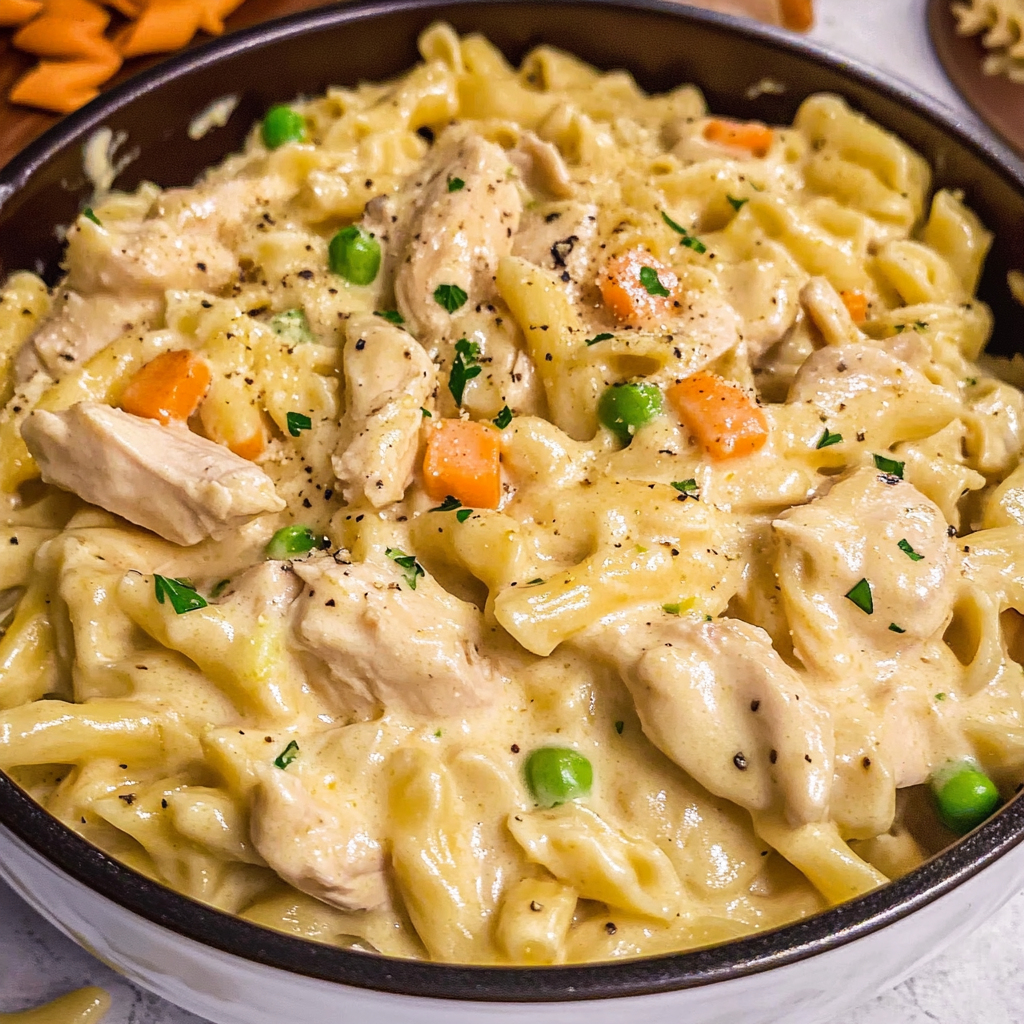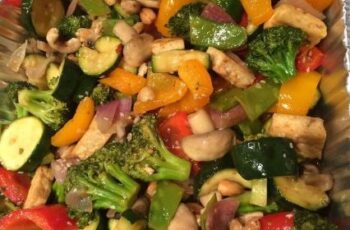
Imagine a dish that wraps the soul-warming goodness of a classic comfort meal into a creamy, pasta-packed delight. This recipe blends tender boneless thighs, aromatic veggies, and a velvety sauce for a fusion that’s both nostalgic and fresh. It’s like your favorite pot pie decided to skip the crust and cozy up with al dente noodles instead.
What makes this creation special? It’s all about balance. Fresh onion, celery, and garlic sautéed in olive oil and butter create a savory base. Combined with box broth and shredded cheese, these ingredients transform into a rich, satisfying sauce that clings perfectly to every bite of pasta. The result? A texture that’s hearty without feeling heavy.
Perfect for weeknights or casual gatherings, this dish simplifies prep work without skimping on flavor. Chopped vegetables cook quickly, while the creamy sauce comes together in one pan. Ready to dive into this twist on tradition? Let’s break down how to make it shine.
Key Takeaways
- Combines classic pot pie flavors with pasta for a modern comfort food upgrade
- Uses fresh aromatics like onion, celery, and garlic for depth of flavor
- Balances richness with light, al dente noodles and fresh vegetables
- Features a creamy sauce made with quality olive oil and butter
- Simple preparation using boneless thighs and boxed broth for convenience
- Versatile recipe adaptable to different cheeses or seasonal veggies
Introduction: A New Take on a Classic Dish
What happens when two beloved classics collide in your dinner bowl? This reinvented comfort food mashup swaps flaky pastry for twirlable noodles while keeping every bit of that homestyle charm. Born from the desire to simplify weeknight cooking, it turns nostalgic flavors into a 45-minute meal that feels both familiar and exciting.
The Fusion of Comfort Food Traditions
Many grew up with frozen pot pie trays or Sunday casseroles bubbling in the oven. Today’s home cooks crave those same cozy vibes without the lengthy prep. By pairing tender protein and veggies with short pasta shapes, this recipe bridges generations – perfect for busy families or solo dinner wins.
Dietary needs? No problem. Try these easy swaps:
| Traditional | Modern Adaptation | Prep Time |
|---|---|---|
| Wheat pasta | Brown rice noodles | Same 10-12 minutes |
| Heavy cream | Coconut milk | No extra steps |
| Butter crust | Naturally crust-free | 45-minute total cook |
Whether you’re upgrading store-bought shortcuts or honoring Grandma’s secret ingredient, this dish adapts to your story. The secret lies in building layers of flavor – sautéed aromatics, savory broth, and a creamy finish that hugs each noodle. Just like your favorite childhood meal, but ready before the oven finishes preheating.
Exploring Chicken Pot Pie Pasta Flavors
The magic of this dish lies in its ability to wrap familiar flavors in a new form. Each bite delivers harmony between indulgence and nourishment, creating a meal that satisfies both cravings and practical needs.
Balancing Creamy and Hearty Elements
Savory shredded poultry forms the foundation, its natural juices mingling with garden-fresh vegetables. A trio of carrots, peas, and celery adds crisp texture while delivering essential vitamins. The sauce – a blend of rich broth and melted cheese – coats every ingredient without overwhelming delicate tastes.
Smart seasoning elevates simple components. A pinch of thyme and cracked black pepper adds depth, while a splash of lemon brightens the creaminess. This careful layering ensures no single flavor dominates, creating a profile that’s both comforting and sophisticated.
| Flavor Component | Role in Dish | Nutritional Benefit |
|---|---|---|
| Shredded Poultry | Primary protein source | Supports muscle health |
| Fresh Vegetables | Adds texture and sweetness | Vitamin-rich foundation |
| Herb Seasoning | Enhances natural flavors | Antioxidant properties |
Inspired by Childhood Memories
That first forkful often sparks recollections of family dinners past. The aroma of simmering broth and toasted herbs acts like a time machine, transporting eaters to simpler days. Yet modern tweaks – like al dente noodles instead of pastry – keep the experience fresh and exciting.
This recipe proves comfort food can evolve while keeping its soul intact. Whether served at weeknight tables or holiday gatherings, it creates new traditions while honoring old ones. Every creamy, vegetable-studded bite feels like coming home.
Key Ingredients and Their Roles
Every great recipe starts with its building blocks – the ingredients that create harmony between flavor and texture. Let’s explore what makes this dish both indulgent and nourishing.
Essential Components for Rich Flavor
Heavy cream forms the sauce’s velvety base, adding luxurious richness without overwhelming other elements. Fresh carrots contribute natural sweetness and vibrant color, balancing the savory notes from broth and herbs.
A pinch of thyme works magic here. Its earthy aroma enhances the poultry’s savoriness while complementing root vegetables. Quality olive oil and butter (the good fat!) build depth during sautéing, creating layers that simple substitutions can’t replicate.
Nutritional Benefits at a Glance
This dish packs more than just taste. Carrots deliver vitamin A for eye health, while lean protein supports muscle maintenance. The controlled use of salt amplifies flavors without exceeding daily sodium limits.
Though heavy cream adds calories, it provides satiating fats that keep you fuller longer. Combined with fiber-rich veggies, it creates a meal that satisfies both cravings and nutrition goals. Smart cooking techniques like quick sautéing preserve nutrients while maximizing taste.
Step-by-Step Cooking Method
Ready to transform simple ingredients into a crowd-pleasing meal? Follow this foolproof guide to layer flavors and textures like a pro. We’ll break the process into manageable stages for stress-free execution.
Preparing the Protein and Veggies
Start by heating olive oil in a deep skillet over medium flame. Season boneless thighs with salt and pepper, then brown them for 4 minutes per side. Remove and set aside – they’ll finish cooking later.
In the same pan, toss diced onions and celery. Sauté until translucent, about 3 minutes. Add minced garlic and carrots, stirring until fragrant. This builds a flavor foundation that permeates every bite.
| Ingredient | Prep Time | Cook Time |
|---|---|---|
| Boneless Thighs | 2 mins | 8 mins |
| Chopped Veggies | 5 mins | 6 mins |
Mastering the Noodles and Sauce
While veggies soften, boil water in a large pot with 1 tbsp salt. Cook short noodles 1 minute less than package instructions – they’ll absorb sauce later. Reserve ½ cup starchy water before draining.
Return the skillet to medium-low heat. Pour in broth and cream, whisking until smooth. Fold in shredded cheese gradually to prevent clumping. Add cooked protein and veggies, then toss with noodles. Adjust thickness with reserved pasta water as needed.
| Pasta Type | Ideal Cook Time | Sauce Absorption |
|---|---|---|
| Fusilli | 9 mins | High |
| Penne | 11 mins | Medium |
Pro tip: Maintain gentle heat when combining elements to prevent sauce separation. Stir just until everything coats evenly – overmixing can break tender ingredients.
Tips and Tricks for Achieving the Perfect Texture
Mastering texture transforms good meals into unforgettable ones. While this recipe shines with creamy comfort, a few pro techniques ensure every bite stays balanced. Let’s explore how to maintain ideal consistency from stove to table.
Keeping Protein Tender and Noodles Al Dente
Cook boneless thighs just until they reach 155°F – they’ll finish cooking in the sauce later. This prevents dryness while ensuring food safety. For pasta, taste-test 2 minutes before the package’s suggested time. “Undercooked noodles have bite; overcooked ones turn to glue,” says chef Marco Pierre.
Monitor heat levels like a hawk:
- Medium-low for simmering sauces (prevents curdling)
- High heat only for initial veggie sautéing
- Off-heat when stirring in cheese (avoids graininess)
Freshly cracked pepper does double duty here. It enhances savoriness while adding subtle heat that cuts through richness. Add half during cooking, then finish with a sprinkle before serving.
| Common Mistake | Smart Fix | Result |
|---|---|---|
| Over-stirring sauce | Fold gently with rubber spatula | Maintains veggie integrity |
| Boiling dairy-based sauce | Keep below simmer | Smooth, lump-free texture |
Remember: Ingredients continue cooking after removal from heat. Pull noodles when they still have slight resistance, and let residual warmth do the rest. Your future self will thank you for that bright, springy bite!
Dietary Options and Ingredient Substitutions
Adapting classic recipes to fit dietary needs doesn’t mean sacrificing flavor. With smart swaps, this creamy dish becomes accessible to everyone – whether avoiding gluten, dairy, or seeking lighter options. Let’s explore how to maintain its soul-warming essence while tailoring it to your nutritional goals.
Gluten-Free and Dairy-Free Alternatives
For gluten-sensitive food lovers, swap regular noodles with brown rice pasta. It cooks in the same time (check package instructions) and holds sauce beautifully. Replace dairy cream with coconut milk or cashew cream – both add lush texture without overpowering other flavors.
Need a crust-like crunch? Try gluten-free breadcrumbs toasted with olive oil. For broth, use chicken bouillon instead of homemade stock – just dissolve one cube per 2 cups of water. This maintains savory depth while simplifying prep.
| Traditional Ingredient | Alternative | Measurement |
|---|---|---|
| Heavy Cream | Coconut Milk | 1:1 ratio |
| Wheat Pasta | Brown Rice Noodles | Same package size |
| Cheese | Nutritional Yeast | 3 tbsp per 2 servings |
Simple Swaps for a Healthier Version
Cut calories without losing taste: use Greek yogurt instead of cream. It adds tang and protein. Reduce sodium by choosing low-sodium chicken bouillon and fresh herbs instead of garlic powder.
For smaller servings, halve the recipe using 1.5 cups of broth and 8 oz pasta. Roast veggies separately to intensify their sweetness – no extra oil needed. “Always taste as you go,” advises nutritionist Lisa Monroe. “Small adjustments create big flavor wins.”
Remember: precise measuring (cups for liquids, scales for dry goods) ensures consistency. Whether feeding two or twelve, these tweaks keep the dish satisfying while aligning with your health journey.
Serving Suggestions and Storage Guidelines
Turn every meal into an occasion with smart presentation and storage know-how. Whether hosting friends or meal-prepping for the week, these tips ensure your creation stays fresh and flavorful from kitchen to table.
Creative Serving Ideas for Any Occasion
Elevate weeknight dinners by topping bowls with crispy fried onions or toasted breadcrumbs. For gatherings, serve in individual ramekins with a sprinkle of fresh herbs. Add a pop of color with steamed peas or roasted cherry tomatoes on the side.
| Occasion | Serving Style | Garnish Idea |
|---|---|---|
| Casual Family Meal | Family-style platter | Lemon wedges |
| Dinner Party | Individual cast iron skillets | Microgreens |
Storing, Making Ahead, and Reheating Tips
Cool completely before transferring to airtight containers. Refrigerate for up to 3 days or freeze portions for 2 months. When reheating, add a teaspoon of broth or water per cup to restore creaminess.
| Storage Method | Max Time | Reheating Tool |
|---|---|---|
| Refrigerator | 72 hours | Large pot + lid |
| Freezer | 8 weeks | Oven-safe dish |
“Always taste before serving leftovers,” advises chef Emily Carter. “A pinch of salt and pepper can revive flavors lost during storage.” For crispy textures, use an air fryer at 375°F for 4 minutes.
Creamy Chicken Pot Pie Pasta
This dish combines the rich, comforting flavors of a classic chicken pot pie with the satisfying texture of creamy pasta—a match made in comfort food heaven!
Hw To Make Creamy Chicken Pot Pie Pasta
Ingredients
10 oz dried egg noodles
3 Tbsp unsalted butter, divided
1 Tbsp olive oil
1 lb boneless, skinless chicken breasts, cut into ½” pieces
1 tsp dried Italian seasoning
1 tsp kosher salt, divided
1 medium yellow onion, diced
2 celery stalks, diced
4 garlic cloves, minced
10-12 oz frozen peas and carrots
8 oz canned whole kernel corn, drained
2 Tbsp all-purpose flour
2 cups reduced-sodium chicken broth
1 cup heavy whipping cream
1 tsp dried parsley
½ tsp black pepper
½ tsp dried thyme
¼ tsp onion powder
¼ tsp garlic powder
¼ tsp paprika
⅛ tsp ground nutmeg
Instructions
Cook the pasta:
Bring a large pot of salted water to a boil. Cook the noodles according to package directions. Drain, toss with a little olive oil to prevent sticking, and set aside.
Sear the chicken:
In a large skillet or shallow Dutch oven, heat 1 Tbsp butter and 1 Tbsp olive oil over medium heat.
Add the chicken, seasoning it with Italian seasoning and ½ tsp salt. Cook for 4-5 minutes, stirring occasionally, until golden and cooked through. Transfer to a plate (keep the skillet as is).
Sauté the vegetables:
Melt the remaining 2 Tbsp butter in the same skillet. Add the onion and celery, cooking for 3-5 minutes until softened.
Stir in the garlic and cook for 30 seconds until fragrant.
Add the frozen peas and carrots along with the corn, mixing well.
Make the creamy sauce:
Sprinkle in the flour, stirring to coat the veggies, and cook for 30 seconds.
Gradually pour in the chicken broth and heavy cream, stirring constantly.
Add the remaining ½ tsp salt, parsley, pepper, thyme, onion powder, garlic powder, paprika, and nutmeg.
Increase heat to medium-high and bring to a boil.
Thicken the sauce:
Once boiling, reduce heat to low and simmer for about 5 minutes, stirring occasionally, until the sauce thickens enough to coat the back of a spoon.
Combine and serve:
Stir in the cooked chicken and pasta until well combined.
Serve hot, garnished with an extra sprinkle of black pepper.
This version keeps the original structure but smooths out the phrasing for better readability while maintaining all key details. Let me know if you’d like any further refinements!
Conclusion
At the crossroads of tradition and innovation lies a meal that reimagines comfort. This recipe masterfully blends the essence of pot pie with the satisfying chew of noodles, creating a modern twist on familiar flavors. Tender protein, garden-fresh veggies, and a velvety sauce come together in under an hour – proof that convenience doesn’t sacrifice taste.
What truly sets this dish apart? Versatility. Whether swapping dairy for coconut milk or using gluten-free noodles, the core experience remains intact. Leftovers store beautifully for quick lunches, while simple garnishes like fresh herbs elevate it for guests.
Ready to make it your own? Whip up this crowd-pleaser, snap a photo of your creation, and tag us with #ComfortFoodRemix. After all, great meals become legendary when shared – just like the classics that inspired them.
FAQ
Can I use a different protein instead of chicken?
Absolutely! Turkey, diced ham, or plant-based alternatives like tofu work well. Adjust cooking times based on your protein choice to maintain tenderness.
How do I prevent the sauce from becoming too thick?
Reserve some pasta water when draining noodles. Stir it into the sauce gradually until you reach your desired consistency. Adding broth or milk also helps thin it out.
What’s the best way to store leftovers?
Keep them in an airtight container in the fridge for up to 3 days. Reheat gently on the stovetop with a splash of broth or cream to revive the creamy texture.
Can I make this recipe gluten-free?
Yes! Swap regular noodles for gluten-free pasta and use cornstarch instead of flour to thicken the sauce. Check labels on broth and seasonings for hidden gluten.
Is there a low-fat alternative to heavy cream?
Try half-and-half or evaporated milk for a lighter option. For dairy-free versions, coconut milk or cashew cream add richness without the saturated fat.
Can I freeze this dish for later?
Freezing isn’t recommended due to the dairy-based sauce, which may separate when thawed. For meal prep, store uncooked veggie-chicken mixtures separately and assemble fresh.
How can I add more veggies to the recipe?
Toss in spinach, mushrooms, or zucchini during the last few minutes of cooking. Frozen mixed vegetables also work well—just thaw and drain excess moisture first.

